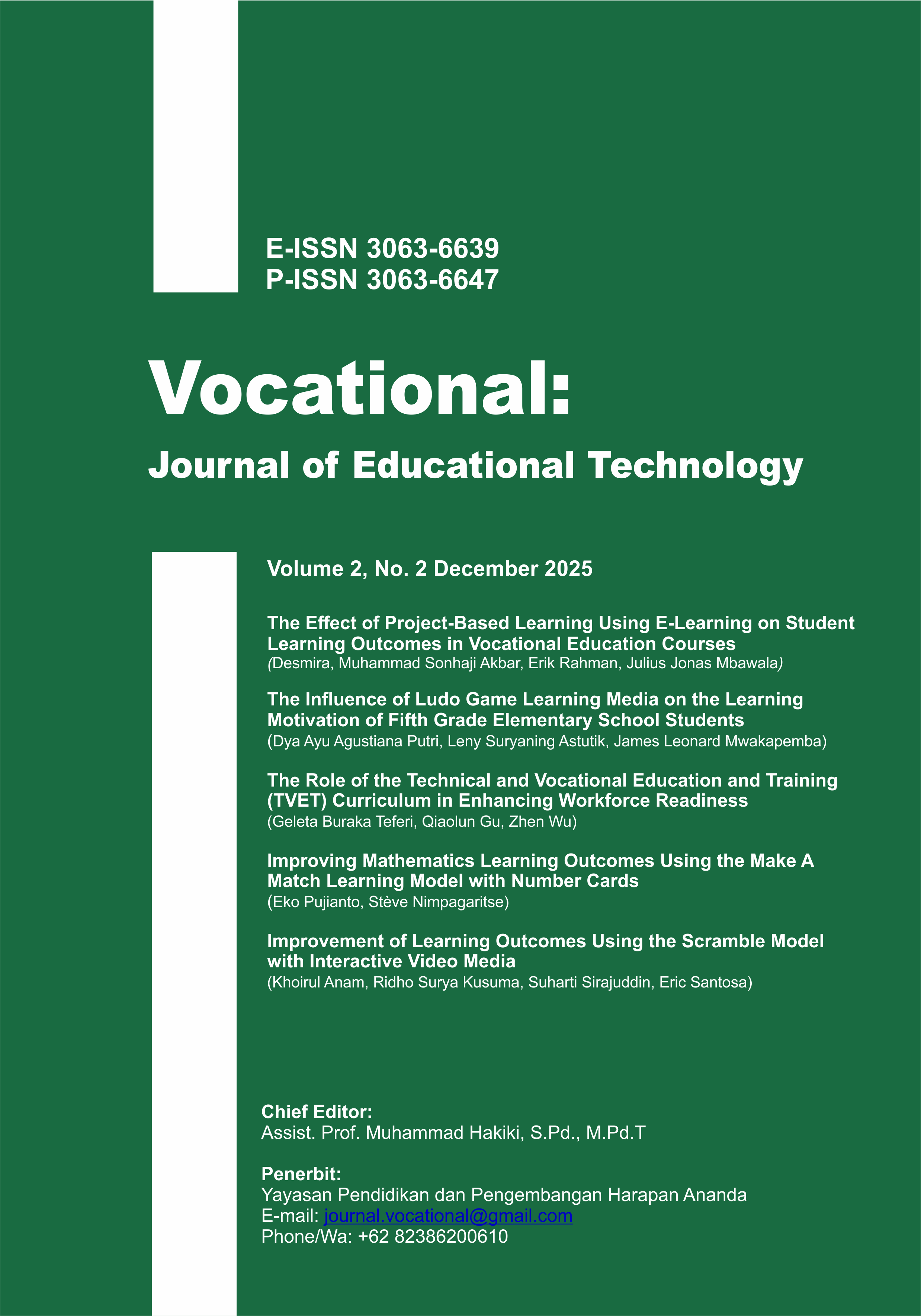Improvement of Learning Outcomes Using the Scramble Model with Interactive Video Media
DOI:
https://doi.org/10.58740/vocational.v2i2.609Keywords:
Scramble Model, Interactive Video, Learning Outcomes, Classroom Action ResearchAbstract
The integration of active learning strategies with digital media has become increasingly essential in higher education to enhance student learning outcomes. This classroom action research investigated the effectiveness of the Scramble learning model supported by interactive video media in improving student achievement in the English Language Education Department at Universitas Negeri Makassar. The study was conducted in two cycles, each consisting of planning, action, observation, and reflection. A total of 32 undergraduate students participated, selected through purposive sampling. Data collection employed tests, observations, and reflective notes, while data analysis combined descriptive statistics with normalized gain (N-gain) to evaluate improvements in learning outcomes. The findings showed consistent progress across cycles. Average student performance improved significantly from the baseline measurement to the second cycle, demonstrating that the instructional strategy effectively supported knowledge acquisition. Moreover, the integration of Scramble activities with interactive video fostered greater classroom engagement, collaboration, and motivation. Students responded positively to the use of multimedia-based tasks, which provided a more dynamic and student-centered learning environment. The study concludes that the Scramble model, when combined with interactive video media, is a highly effective approach to improving learning outcomes in teacher education courses. Beyond raising academic achievement, this model also contributes to enhancing students’ critical thinking, active participation, and collaborative learning. These findings highlight the potential of technology-enhanced active learning models to address challenges in higher education and provide meaningful benefits for both teaching practice and student development.
References
N. Qodri and Q. M. A. Hassan, “Comparison of Concept Understanding Using the Scramble Learning Method Between Courselab Interactive Media and Microsoft Powerpoint Media”, Tekno-Pedagogi. Jur. Tek. Pend, vol. 13, no. 1, pp. 50–59, Apr. 2023. https://doi.org/10.22437/teknopedagogi.v13i1.38455
Ismawati, M. A. Bakar, and M. A. Zamroni, “Improving Students’ Critical Thinking Skills Through the Application of the Scramble Learning Model”, adrg, vol. 4, no. 1, pp. 65–78, Aug. 2024. https://doi.org/10.31538/adrg.v4i1.1293
Taufiq, A. R., & Setyawan, A. (2025). The Effect of the Scramble Game-Type Cooperative Learning Model Assisted by Canva Media on Second-Grade Elementary School Students’ Learning Outcomes. Widyagogik: Jurnal Pendidikan dan Pembelajaran Sekolah Dasar, 13(2), 112-129. https://doi.org/10.21107/widyagogik.v13i2.30366
Yasin, M., Huda, S., Septiana, R., & Palupi, E. K. (2020, February). Mathematical critical thinking ability: The effect of scramble learning model assisted by prezi in islamic school. In Journal of Physics: Conference Series (Vol. 1467, No. 1, p. 012007). IOP Publishing. https://doi.org/10.1088/1742-6596/1467/1/012007
Yuliana, Y., & Nurhayati, E. (2025). The Effect of Scramble Learning Model on Student Learning Outcomes. JLER (Journal of Language Education Research), 8(2), 68-81. https://doi.org/10.22460/jler.v8i2.25637
Y. Rostiana and A. Imran, “Implementation of the Scramble Learning Model and Its Effect on Student Motivation and Learning Outcomes”, J. Inov. Pendidik. Pemb., vol. 1, no. 1, pp. 14–20, Jun. 2024. https://doi.org/10.63757/pjipp.v1i1.8
N. Talia and G. S. Airlanda, “The Effectiveness of Problem-Based Learning and Scramble Models in Enhancing Critical Thinking Skills of Fifth Grade Elementary School Students in Integrated Science and Social Studies”, JIRPE, vol. 4, no. 3, pp. 557–564, Jul. 2025. https://doi.org/10.56916/jirpe.v4i3.1404
Sukerti, N. K., & Pudjawan, K. (2021). The Positive Effect of Scramble Learning Model Assisted by Picture Cards on Students’ Learning Outcomes. International Journal of Elementary Education, 4(4), 481–487. https://doi.org/10.23887/ijee.v4i4.27216
D. Wulansari and D. N. Tyas, “The Development of Interactive Picture Card Media with QR Code to Improve IPAS Learning Outcomes”, J. Prim. Edukasia, vol. 13, no. 2, pp. 213–224, Jul. 2025. https://doi.org/10.21831/jpe.v13i2.84474
D. Aprilia, K. Kintoko, and D. H. Siswanto, “Effectiveness of the Scramble Learning Model on Students’ Ability to Understand Mathematical Concepts”, Contemp. Educ. Community Engagem., vol. 2, no. 1, pp. 64–73, Jan. 2025. https://doi.org/10.12928/cece.v2i1.1282
Aradea, R., Cahyono, S., Sasongko, R. N., Kristiawan, M., & Lestari, N. D. (2022). The Impact of a Scramble-Based Cooperative Learning Model Using Video Media on Student Learning Outcomes. AL-ISHLAH: Jurnal Pendidikan, 14(4), 6551-6558. https://doi.org/10.35445/alishlah.v14i4.2315
Downloads
Published
How to Cite
Issue
Section
License
Copyright (c) 2026 Khoirul Anam, Ridho Surya Kusuma, Suharti Sirajuddin, Eric Santosa

This work is licensed under a Creative Commons Attribution 4.0 International License.













